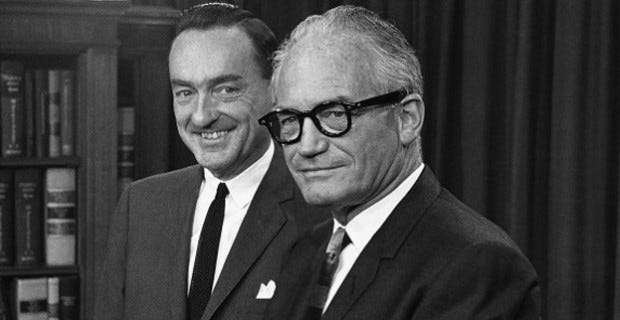In the 1964 presidential campaign, in which Lyndon B. Johnson and Hubert H. Humphrey ran against Barry M. Goldwater and William E. Miller (remember him?), the country was still coping with of the assassination of President John F. Kennedy in November 1963, less than a year earlier.
The shock reverberated for many reasons and marked one major change in American life. It ended a period of relative calm and stability, to be replaced by the decades of turmoil and division that are the case as we approach the 2024 presidential election on November 5.
American voters are fragmented, from the far left to the far right. Issues of inequality, race, and gender are prominent. Socialist, extremist, and terrorist are all epithets. There are distant wars in which Americans play significant roles, but with very few losses of life, yet.
Those are among the rhymes. The rhythms are of scale.
The population of the country in 1964 was approximately 190 million people. Johnson and Humphrey received 43.1 million votes, or 61.1 percent of the popular vote. Goldwater and Miller got 27.2 million or 38.5 percent, a singular landslide — as reflected by the electoral vote, which was 486-52 in favor of LBJ.
The U.S. population in 2024 stands at roughly 336 million people. At the last presidential election in 2020, the number of registered voters was in the neighborhood of 168 million. Joe Biden received 81.3 million votes or 51.3 percent of the popular vote. Donald Trump received 74.2 million or 46.9 percent, and Biden prevailed in the Electoral College (which Trump refuses to acknowledge).
Projections for 2024, less than a month out, suggest that the popular vote this time will be nearly evenly split, at 50-50, and certainly within the margin of error for most polls.
Expenditures on political campaigns in 1964 were more than $200 million, which was a record sum at the time. The forecast for this year is that at least $15.9 billion will be spent.
And for all that spending, the outcome of the presidential contest is expected to be decided by a few hundred thousand voters in seven battleground states. With America’s deep political divisions even wider than they were in 1964, the margin is astonishingly close.
Another difference in scale is the style, ferocity, and noise of the campaigns. The World Book Encyclopedia called the process in 1964 “Public Relations,” which seems descriptively staid compared to this year in which Donald Trump and J. D. Vance have abandoned all rhetorical boundaries in attacking Vice President Kamala Harris and Tim Walz.
The most memorable moment of the Goldwater campaign was the assertion in his convention acceptance speech that “Extremism in the defense of liberty is no vice. . . . Moderation in the pursuit of justice is no virtue,” which by modern standards has a semblance of eloquence. And whatever the worst thing Goldwater may have said about Johnson, historians record that the two men agreed not to use racial biases against each other in speeches or ads.
The dramatic highlight of LBJ’s campaign was a television ad that became famous as “Daisy,” the image of a little girl picking flowers which morph into a nuclear explosion, intended to portray Goldwater as a danger to the world because of his opposition to nuclear treaties with the Soviet Union and all-out support for the still incipient war in Vietnam — which Johnson insisted he would not escalate, but then did. This ad was considered so provocative that it aired only once, weeks before the election.
As for scandals that fall, the one that rattled the Democrats was the arrest in a YMCA near the White House of Johnson’s close aide Walter Jenkins, for having sex with another man. It was just weeks before the election. Jenkins immediately resigned, and there is no sense that I found that the episode had any significant effect on the election.
As for Trump, felony convictions, impeachments, sexual assault cases and the rest – if polls and commentary are to be believed — do not matter greatly to the Republican constituency or to the candidates at every level who have endorsed Trump. In these sixty years since 1964, Americans seem to have become inured to what once would have seemed unfathomable.
Perhaps the biggest change — and it is positive — since 1964 has to do with racial progress and the composition of the electorate.
At the 1964 Democratic convention in Atlantic City, the Mississippi Freedom Democratic Party, led by Fannie Lou Hamer, sought recognition instead of the all-white official state delegation. The issue was contentious, and the MFDP and civil rights activists protested on the boardwalk. In the end, the MFDP (grudgingly) received just two delegates.
With Kamala Harris at the head of the Democrats’ 2024 ticket, combined with the composition of delegates at the convention, down-ballot candidates, and crowds at rallies, the extent of the country’s evolution on what to expect in their office seekers when it comes to race, gender and sexual orientation is profound — and deeply impressive.
So, whatever rhyme and rhythm similarities there may be, the differences ultimately are vast, especially in one respect. When the clichés about the future of the country are deployed, there is no doubt that this time they deserve to be taken as seriously as they sound.
* Rep. William E. Miller (R/NY) This is a correction. Previous version had him in Pennsylvania, not surprising I guess.
*******************
The first book review for “LBJ and McNamara: The Vietnam Partnership Destined to Fail” comes from Kirkus with a star: “Insightful and Informative…benefits from Osnos’ unique insights”







Caught and fixed. Tks.